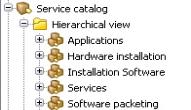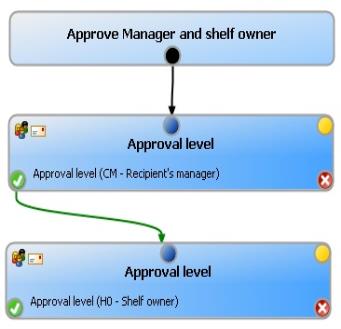The IT Shop allows users to request company resources such as software, system roles, or group membership as well as non-IT resources such as mobile telephones or keys. Furthermore, membership of a hierarchical role (department, location, cost center, or business role) can be requested through the IT Shop. The requests are processed by a flexible policy-based approval process. Introducing the IT Shop avoids time-consuming demands within the company and reduces the administration effort. The request history makes it possible to follow who requested which company resource or hierarchical role and when it was requested, renewed, or canceled.
Shops, shelves, customers, and products all belong to an IT Shop solution. Several shops can be grouped together into shopping centers. The shelves are assigned company resources in the form of products. Products can be grouped into service categories. All the service categories are summarized in a service catalog. Customers can select products from a service catalog in the Web Portal, add them to a cart, and send a purchase request.
The following figure shows an example of a service catalog with service categories.
Figure 1: Example of a service catalog

Requests follow a defined approval process that determines whether a product may be assigned or not. Products can be renewed or canceled. Approval processes can also be specified for renewals and cancellations. Approval policies are defined for approval processes. The approval policies are assigned to approval workflows for product requests, renewals, or cancellations.
Figure 2: Example of a simple approval workflow

The products are requested, renewed, and canceled through the Web Portal. Authorized employees have the option to approve requests and cancellations. For detailed information, see the One Identity Manager Web Portal User Guide.
The following users are involved in the setting up and operating of an IT Shop system.
Table 1: Users
|
Administrators for the IT Shop |
Administrators must be assigned to the Request & Fulfillment | IT Shop | Administrators application role.
Users with this application role:
- Create the IT Shop structure with shops, shelves, customers, templates, and service catalog.
- Create approval policies and approval workflows.
- Specify which approval procedure to use to find attestors.
- Create products and service items.
- Set up request notifications.
- Monitor request procedures.
- Administrate application roles for product owners and attestors.
- Set up other application roles as required.
- Create extended properties for company resources of any type.
- Edit the resources and assign them to IT Shop structures and employees.
- Assign system entitlements to IT Shop structures.
|
|
Product owners |
Product owners must be assigned to the Request & Fulfillment | IT Shop | Product owners application role or a child application role.
Users with this application role:
- Approve through requests.
- Edit service items and service categories under their management.
|
|
One Identity Manager administrators |
-
Create customized permissions groups for application roles for role-based login to administration tools in the Designer as required.
-
Create system users and permissions groups for non role-based login to administration tools in the Designer as required.
-
Enable or disable additional configuration parameters in the Designer as required.
-
Create custom processes in the Designer as required.
-
Create and configure schedules as required.
-
Create and configure password policies as required. |
|
Role approver |
- Request approval in the Web Portal.
Approvers are determined through approval procedures. |
|
Attestors for requests |
Attestors must be assigned to the Request & Fulfillment | IT Shop | Attestors application role.
Users with this application role:
- Attest correct assignment of company resource to IT Shop structures for which they are responsible.
- Can view master data for these IT Shop structures but not edit them.
NOTE: This application role is available if the module Attestation Module is installed. |
|
Chief approval team |
Chief approvers must be assigned to the Request & Fulfillment | IT Shop | Chief approval team application role.
Users with this application role:
- Approve through requests.
- Assign requests to other approvers.
|
Identity & Access Lifecycle is already included in the default installation of One Identity Manager. This shop contains several shelves that have standard products assigned to them. You can use these products to request role or group memberships, for example, or to delegate duties. All active employees automatically become members of this shop and can therefore make requests.
You can use the Identity & Access Lifecycle shop to request standard products. Default approval policies are implemented for approving these requests. You can request any company resources you like by taking the default shop and extending it with your own shelves or by setting up your own IT Shop solution.
To use the Identity & Access Lifecycle shop
- In the Designer, set the QER | ITSHOP configuration parameter.
In the default installation, the configuration parameter is set and the IT Shop is available. If the configuration parameter is not set, you can set it in the Designer and then compile the database.
- Install and configure the Web Portal.
The products are requested, renewed, and canceled through the Web Portal. Authorized employees have the option to approve requests and cancellations.
For more information about this, see the One Identity Manager Installation Guide and the One Identity Manager Web Portal User Guide.
Important: This shop's customers are determined by a dynamic role. If a shop contains a large number of customers, the calculations in the
IT Shop can cause a heavy load on the
DBQueue Processor and therefore on the database server, as well.
Formulate the condition for the dynamic role so that no more than 30,000 employees are found. If necessary, set up your own IT Shop solution with several shops and customer nodes.
To customize the Identity & Access Lifecycle shop
- Set up more shelves.
For more information, see Managing an IT Shop.
- Prepare company resources for requesting.
For more information, see Preparing products for requesting.
- Assign requestable products to the shelves.
For more information, see Assigning and removing products.
- Set up the approval process.
In the default installation, different default approval policies are assigned to the Identity & Access Lifecycle shop. Therefore, requests from this shop are run through predefined approval processes.
You can also assign your own approval policy to the shop. For more information, see Approval processes for IT Shop requests.
- If necessary, edit the dynamic role condition.
For more information, see Assigning employees through dynamic roles. For more information about creating the condition, see the One Identity Manager Identity Management Base Module Administration Guide.
To set up your own IT Shop solution
- In the Designer, set the QER | ITSHOP configuration parameter.
In the default installation, the configuration parameter is set and the IT Shop is available. If the configuration parameter is not set, you can set it in the Designer and then compile the database.
- Set up shops, shelves, and customer node.
For more information, see Managing an IT Shop.
- Prepare company resources for requesting.
For more information, see Preparing products for requesting.
- Assign requestable products to the IT Shop.
For more information, see Assigning and removing products.
One Identity Manager makes different default products available, which can be requested through the Identity & Access Lifecycle shop. You can also add these standard products to your own IT Shop.
- Set up the approval process.
For more information, see Approval processes for IT Shop requests.
- Install and configure the Web Portal.
The products are requested, renewed, and canceled through the Web Portal. Authorized employees have the option to approve requests and cancellations.
For more information about this, see the One Identity Manager Installation Guide and the One Identity Manager Web Portal User Guide.
Requestable products in the IT Shop are company resources such as target system groups, software, and non-IT resources after they have been assigned to a shelf. The following company resources can be assigned to shelves as requestable products.
Table 2: Requestable products
|
Groups of custom target systems |
Target System Base Module |
One Identity Manager Target System Base Module Administration Guide |
|
Active Directory groups |
Active Directory Module |
One Identity Manager Administration Guide for Connecting to Active Directory |
|
SharePoint groups and SharePoint roles |
SharePoint Module |
One Identity Manager Administration Guide for Connecting to SharePoint |
|
IBM Notes groups |
IBM Notes Module |
One Identity Manager Administration Guide for Connecting to IBM Notes |
|
LDAP groups |
LDAP Module |
One Identity Manager Administration Guide for Connecting to LDAP |
|
SAP groups, SAP roles, and SAP profiles |
SAP R/3 User Management Module |
One Identity Manager Administration Guide for Connecting to SAP R/3 |
|
SAP structural profiles |
SAP R/3 Structural Profiles Add-on Module |
One Identity Manager Administration Guide for SAP R/3 Structural Profiles Add-on |
|
SAP BI analysis authorizations |
SAP R/3 Analysis Authorizations Add-on Module |
One Identity Manager Administration Guide for SAP R/3 Analysis Authorizations Add-on |
|
E-Business Suite permissions |
Oracle E-Business Suite Module |
One Identity Manager Administration Guide for Connecting to Oracle E-Business Suite |
|
Azure Active Directory groups |
Azure Active Directory Module |
One Identity Manager Administration Guide for Connecting to Azure Active Directory |
|
Azure Active Directory administrator roles |
Azure Active Directory Module |
One Identity Manager Administration Guide for Connecting to Azure Active Directory |
|
G Suite groups, G Suite products, and SKUs |
G Suite Module |
One Identity Manager Administration Guide for Connecting to G Suite |
|
Resources |
Identity Management Base Module |
One Identity Manager Identity Management Base Module Administration Guide |
|
Multi-request resources |
Identity Management Base Module |
One Identity Manager Identity Management Base Module Administration Guide |
|
Account definitions |
Target System Base Module |
One Identity Manager Target System Base Module Administration Guide |
|
System roles |
System Roles Module |
One Identity Manager System Roles Administration Guide |
|
Subscribable reports |
Report Subscription Module |
One Identity Manager Report Subscriptions Administration Guide |
|
Software |
Software Management Module |
One Identity Manager Software Management Administration Guide |
|
Assignment resources |
Identity Management Base Module
Business Roles Module |
Use assignment resources to request any number of assignments to hierarchical roles or to delegate responsibilities through the IT Shop. For more information, see Assignment requests and delegating. |
|
Azure Active Directory groups |
Azure Active Directory Module |
One Identity Manager Administration Guide for Connecting to Azure Active Directory |
|
Azure Active Directory administrator roles |
Azure Active Directory Module |
One Identity Manager Administration Guide for Connecting to Azure Active Directory |
|
PAM user groups |
Privileged Account Governance Module |
One Identity Manager Administration Guide for Privileged Account Governance |
|
Password requests |
Privileged Account Governance Module |
One Identity Manager Administration Guide for Privileged Account Governance |
|
Remote desktop session requests |
Privileged Account Governance Module |
One Identity Manager Administration Guide for Privileged Account Governance |
|
SSH session requests |
Privileged Account Governance Module |
One Identity Manager Administration Guide for Privileged Account Governance |
|
Telnet session requests |
Privileged Account Governance Module |
One Identity Manager Administration Guide for Privileged Account Governance |
Software and system roles can also be requested for workdesks. The request's UID_Workdesk is given as additional information here (PersonWantsOrg.UID_WorkdeskOrdered).


